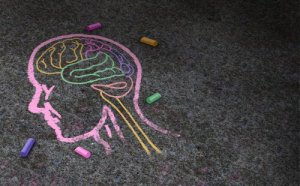Intellectual Disability and Severity Codes

Knowing about the severity scale allows us to better understand how intellectual disability is assessed and how a certain diagnosis is categorized into any of the four identified severity codes.
What is an intellectual disability?
An intellectual disability is a neurodevelopmental disorder, that is, a disorder that is diagnosed in childhood. Furthermore, it’s characterized by cognitive deterioration and by the difficulty to adapt conceptually, socially, and practically.

Parents of disabled children
For an intellectual disability to be diagnosed, the following three characteristics must be present:
- Cognitive impairment: Difficulty with problem-solving, planning, reasoning, etc. Moreover, it’s common for a child to have difficulties in school, planning home activities, or even playing and relating to others.
- Difficulty adapting conceptually, socially, and practically: The child has a hard time with personal autonomy, social responsibility, social communication, etc. Henceforth, this is detected when a child is forced to communicate with other people, regardless of their age.
- Manifests during development: All these symptoms must manifest during childhood.
Once an intellectual disability is detected, it’s time to determine its severity. To do this, professionals use the intellectual disability severity scale, where they take into account not only a person’s level of cognitive ability but also their ability to adapt.
Intellectual disability and severity codes
Taking into account that cognitive capacity is altered, an evaluation is complemented with a qualitative analysis of the person’s adaptive abilities.
Thus, the scale consists of three areas related to social adaptation:
- Conceptual domain: The understanding and use of abstract thinking. For example, the understanding of symbolic language and the understanding and use of time and money, among other things.
- Social domain: It refers to a person’s socialization skills. In other words, with whom they do what, the way in which they do it, and the social tools they use to express themselves.
- Practical domain: This is characterized by personal care, hygiene, and work development skills, among others.
Identifying different levels
Mild intellectual disability
On many occasions, this type of intellectual disability goes unnoticed. Many of these people achieve independence and are able to adapt to lead a normal life. Thus, they can compensate for their lack of cognitive fluency via manual labor or by simply spending more time on a task.
Often, their difficulties are confused with disinterest, distraction, bad mood, lack of motivation, etc. In addition, these individuals usually need more time to learn. Moreover, they have difficulties with planning, abstract reasoning, determination of strategies, and priorities.
They’re able to learn language and arithmetic, but have a hard time when they become more complex.
They can communicate within their social environment in an acceptable manner. However, most of these disabilities show, in the case of children, during game time.
In short, a person with this degree of disability is able to develop conceptual, social, and practical skills, but at a more basic level than a person without a disability.
Moderate intellectual disability
Unlike the previous one, this diagnosis is more reserved. Furthermore, the weaknesses in their conceptual, social and practical skills are more evident. Moreover, a person with this disability isn’t fully independent.
The learning capacity of these individuals is more limited. Therefore, the lack of development in their conceptual skills makes it hard for them to work with abstract concepts. Thus, when they have to work with realities that aren’t tangible or have no hypotheses, they feel lost. In addition, they’re limited in social environments.
Their practical skills depend more on external support. Also, their practical activities, such as personal care, hygiene, and domestic activities, require a longer learning time.
Serious intellectual disability
People who are diagnosed with this disability have no significant conceptual learning. Thus, complex symbolic understanding isn’t expected and a more material understanding is present.
The main tools for social development for these individuals are simple phrases, in addition to gestures. Furthermore, their social circle includes their family only.
Thus, the person is highly dependent.
Deep intellectual disability
An individual with this diagnosis is an entirely dependent person. They only socialize through mimicry, particularly when they want or reject something they’ve seen. Most of them are able to follow simple instructions and procedures but in a highly automated manner.
What to do
Now that you know the four subtypes of intellectual disability, you can be a good early screener. Thus, if you detect any of the above symptoms, you better consult a specialist.

Remember the above information, but remain calm in the light of suspicion because stress or anxiety can also affect a person’s cognitive functions. Low academic performance or social disinterest aren’t always caused by an intellectual disability.
Knowing about the severity scale allows us to better understand how intellectual disability is assessed and how a certain diagnosis is categorized into any of the four identified severity codes.
What is an intellectual disability?
An intellectual disability is a neurodevelopmental disorder, that is, a disorder that is diagnosed in childhood. Furthermore, it’s characterized by cognitive deterioration and by the difficulty to adapt conceptually, socially, and practically.

Parents of disabled children
For an intellectual disability to be diagnosed, the following three characteristics must be present:
- Cognitive impairment: Difficulty with problem-solving, planning, reasoning, etc. Moreover, it’s common for a child to have difficulties in school, planning home activities, or even playing and relating to others.
- Difficulty adapting conceptually, socially, and practically: The child has a hard time with personal autonomy, social responsibility, social communication, etc. Henceforth, this is detected when a child is forced to communicate with other people, regardless of their age.
- Manifests during development: All these symptoms must manifest during childhood.
Once an intellectual disability is detected, it’s time to determine its severity. To do this, professionals use the intellectual disability severity scale, where they take into account not only a person’s level of cognitive ability but also their ability to adapt.
Intellectual disability and severity codes
Taking into account that cognitive capacity is altered, an evaluation is complemented with a qualitative analysis of the person’s adaptive abilities.
Thus, the scale consists of three areas related to social adaptation:
- Conceptual domain: The understanding and use of abstract thinking. For example, the understanding of symbolic language and the understanding and use of time and money, among other things.
- Social domain: It refers to a person’s socialization skills. In other words, with whom they do what, the way in which they do it, and the social tools they use to express themselves.
- Practical domain: This is characterized by personal care, hygiene, and work development skills, among others.
Identifying different levels
Mild intellectual disability
On many occasions, this type of intellectual disability goes unnoticed. Many of these people achieve independence and are able to adapt to lead a normal life. Thus, they can compensate for their lack of cognitive fluency via manual labor or by simply spending more time on a task.
Often, their difficulties are confused with disinterest, distraction, bad mood, lack of motivation, etc. In addition, these individuals usually need more time to learn. Moreover, they have difficulties with planning, abstract reasoning, determination of strategies, and priorities.
They’re able to learn language and arithmetic, but have a hard time when they become more complex.
They can communicate within their social environment in an acceptable manner. However, most of these disabilities show, in the case of children, during game time.
In short, a person with this degree of disability is able to develop conceptual, social, and practical skills, but at a more basic level than a person without a disability.
Moderate intellectual disability
Unlike the previous one, this diagnosis is more reserved. Furthermore, the weaknesses in their conceptual, social and practical skills are more evident. Moreover, a person with this disability isn’t fully independent.
The learning capacity of these individuals is more limited. Therefore, the lack of development in their conceptual skills makes it hard for them to work with abstract concepts. Thus, when they have to work with realities that aren’t tangible or have no hypotheses, they feel lost. In addition, they’re limited in social environments.
Their practical skills depend more on external support. Also, their practical activities, such as personal care, hygiene, and domestic activities, require a longer learning time.
Serious intellectual disability
People who are diagnosed with this disability have no significant conceptual learning. Thus, complex symbolic understanding isn’t expected and a more material understanding is present.
The main tools for social development for these individuals are simple phrases, in addition to gestures. Furthermore, their social circle includes their family only.
Thus, the person is highly dependent.
Deep intellectual disability
An individual with this diagnosis is an entirely dependent person. They only socialize through mimicry, particularly when they want or reject something they’ve seen. Most of them are able to follow simple instructions and procedures but in a highly automated manner.
What to do
Now that you know the four subtypes of intellectual disability, you can be a good early screener. Thus, if you detect any of the above symptoms, you better consult a specialist.

Remember the above information, but remain calm in the light of suspicion because stress or anxiety can also affect a person’s cognitive functions. Low academic performance or social disinterest aren’t always caused by an intellectual disability.
This text is provided for informational purposes only and does not replace consultation with a professional. If in doubt, consult your specialist.







